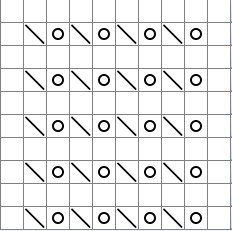 Once you have a few simple projects under your belt, you might want to try out some more complex lace knitting, and that often means that you will need to — or at least have the option to — read and follow a chart instead of text instructions.
Once you have a few simple projects under your belt, you might want to try out some more complex lace knitting, and that often means that you will need to — or at least have the option to — read and follow a chart instead of text instructions.
I know knitting charts can seem intimidating, but they’re really just a visual representation of what your knitting should look like when you work it properly.
Yarn overs, for instance, are represented as Os. Decreases a slants that go the direction the actual decrease goes.
When you’re knitting flat, you work a chart from right to left on the right (or front) side of the work, while you work from left to right on the back/wrong side. Because that’s the direction you’re knitting in relation to the front of the work.
Sometimes in projects that are shaped or where the stitch count changes between rows you’ll see a shaded box that means there is no stitch there to work on that row. That’s easy; just ignore it and move on.
Charts often show just one repeat of the pattern along with the edge stitches, so make sure you’re reading it properly and know which part of it you’re supposed to repeat. (If you mess it up, you’ll know pretty quickly because you won’t have room for a full repeat at the end or your pattern just won’t look right.
It’s a great idea to start knitting from charts by using a pattern that has both written and charted instructions. Look at the chart and translate it into written instructions, then compare to the actual instructions. After you’ve done this once or twice you’ll be confident enough to work patterns that only have charts.
If you’re a lace knitter and you have tips for following charts, I’d love to hear them!
 It seems like every summer there’s a new crop of tank top knitting patterns, and what I noticed about a lot of the new releases this year is that they have fun little details that make them a little more interesting both to knit and to wear.
It seems like every summer there’s a new crop of tank top knitting patterns, and what I noticed about a lot of the new releases this year is that they have fun little details that make them a little more interesting both to knit and to wear.